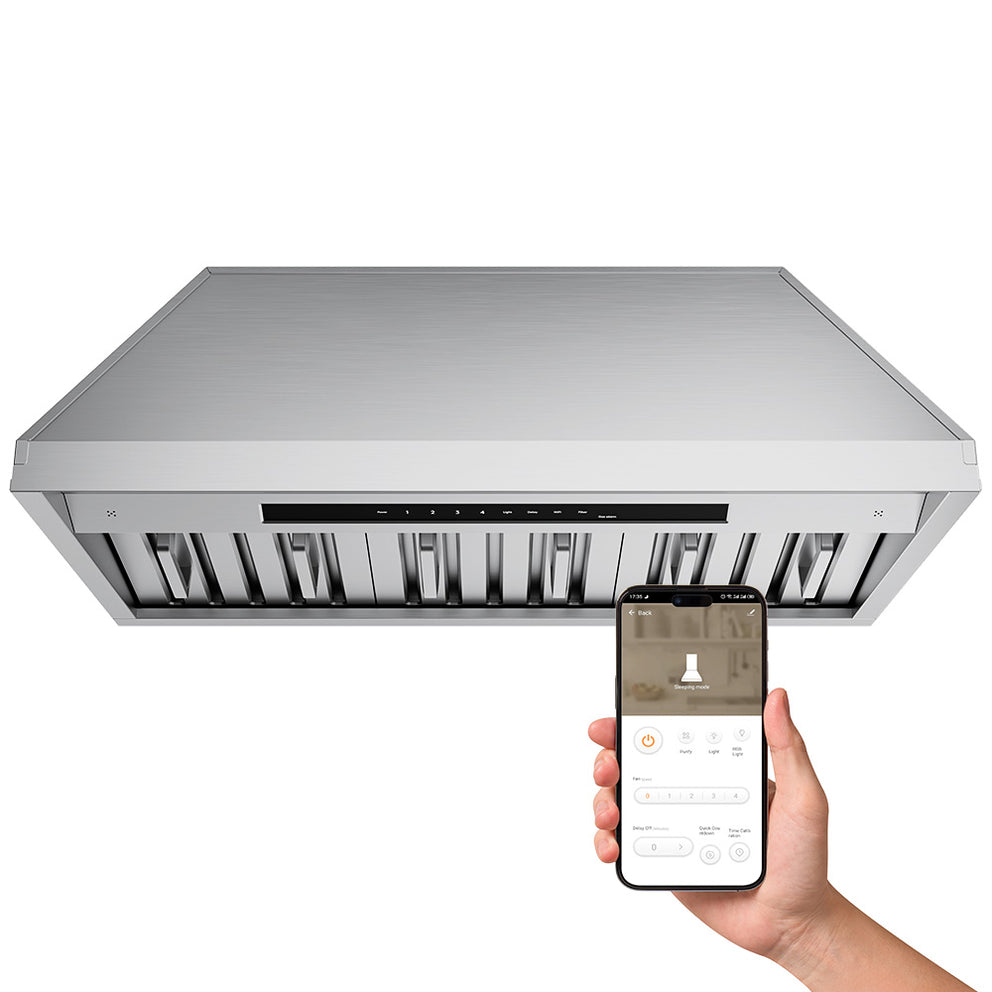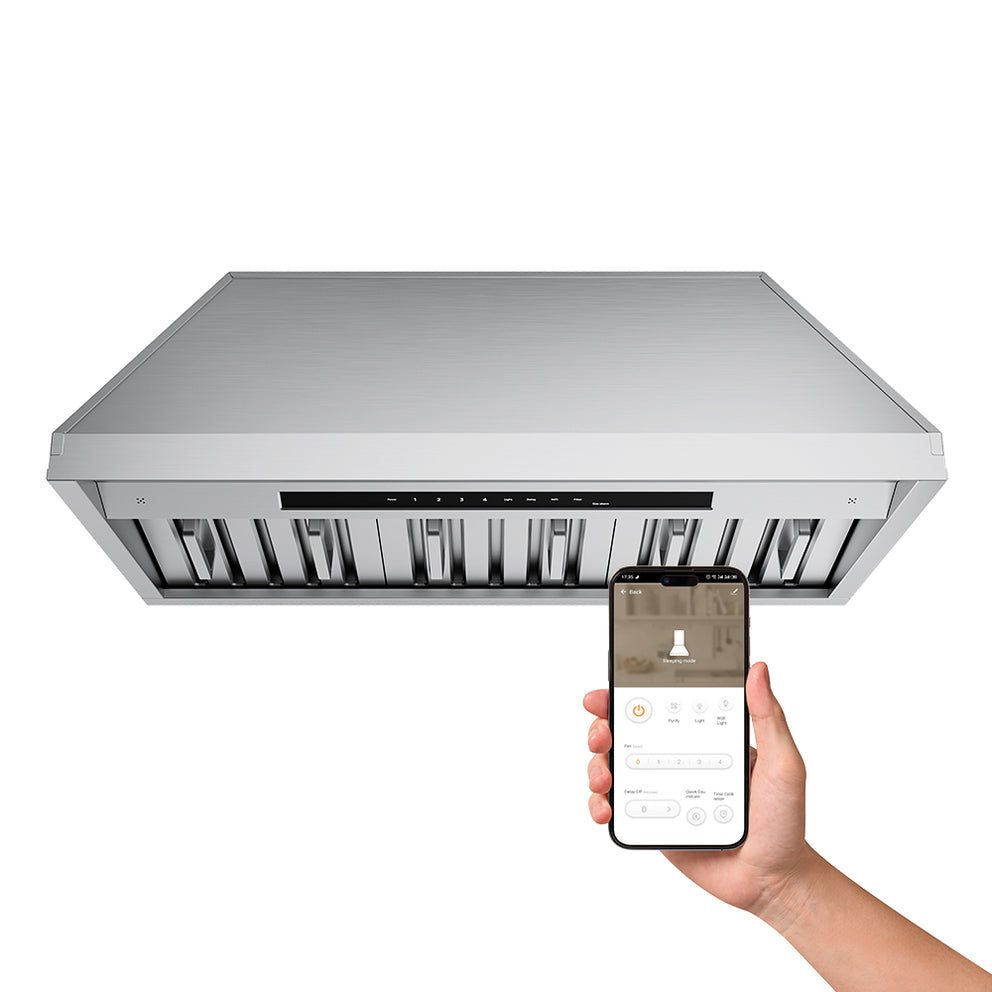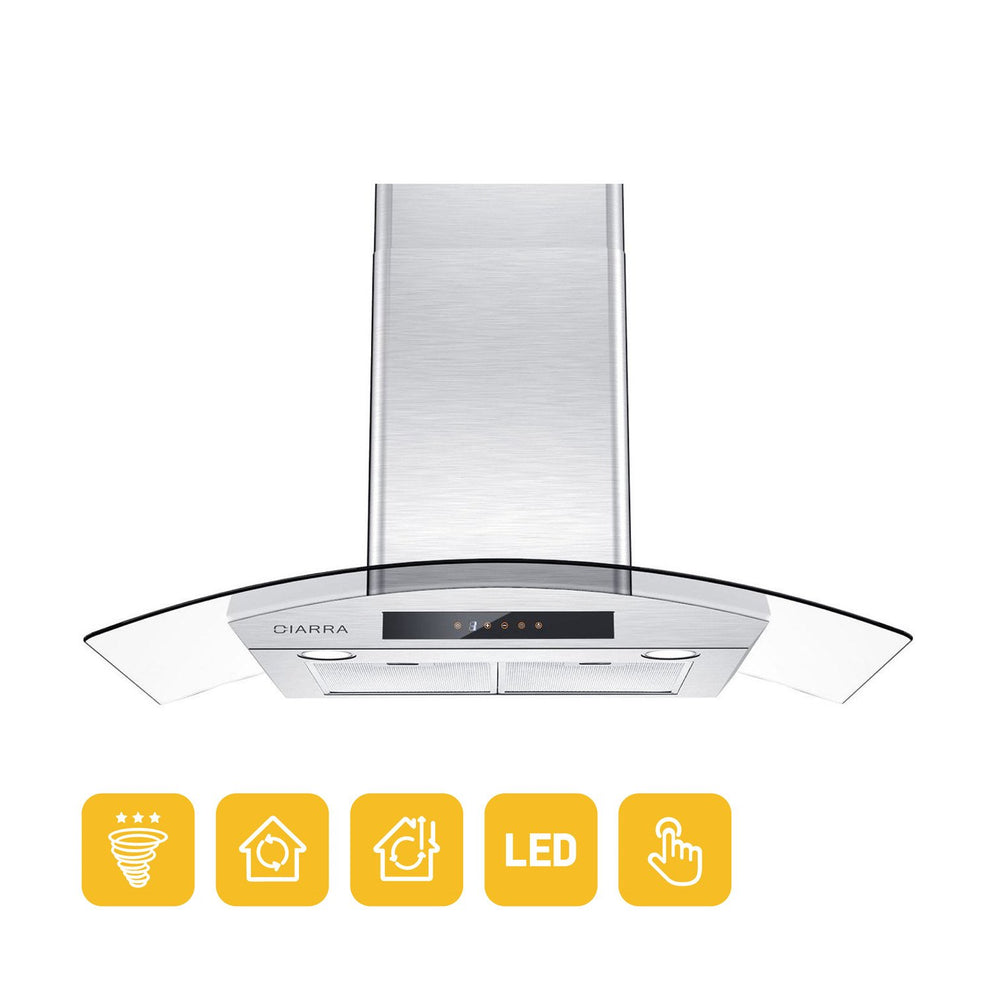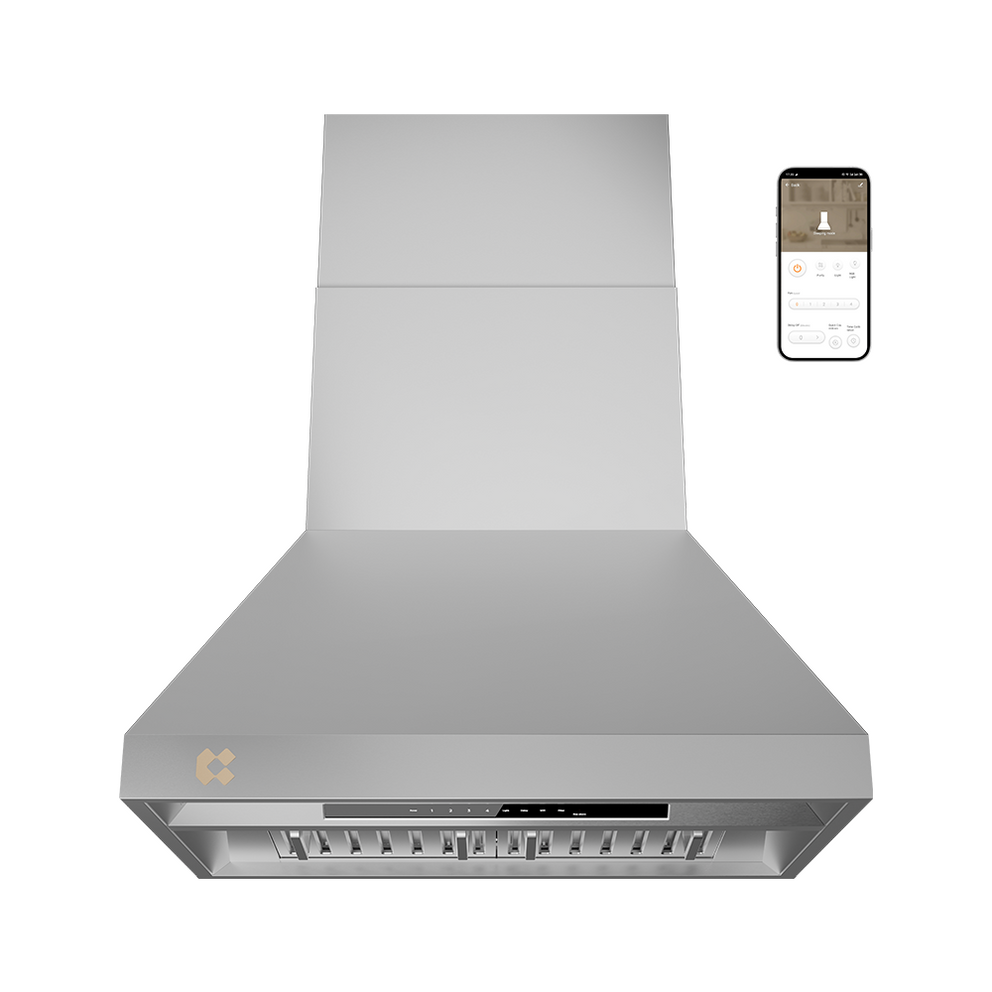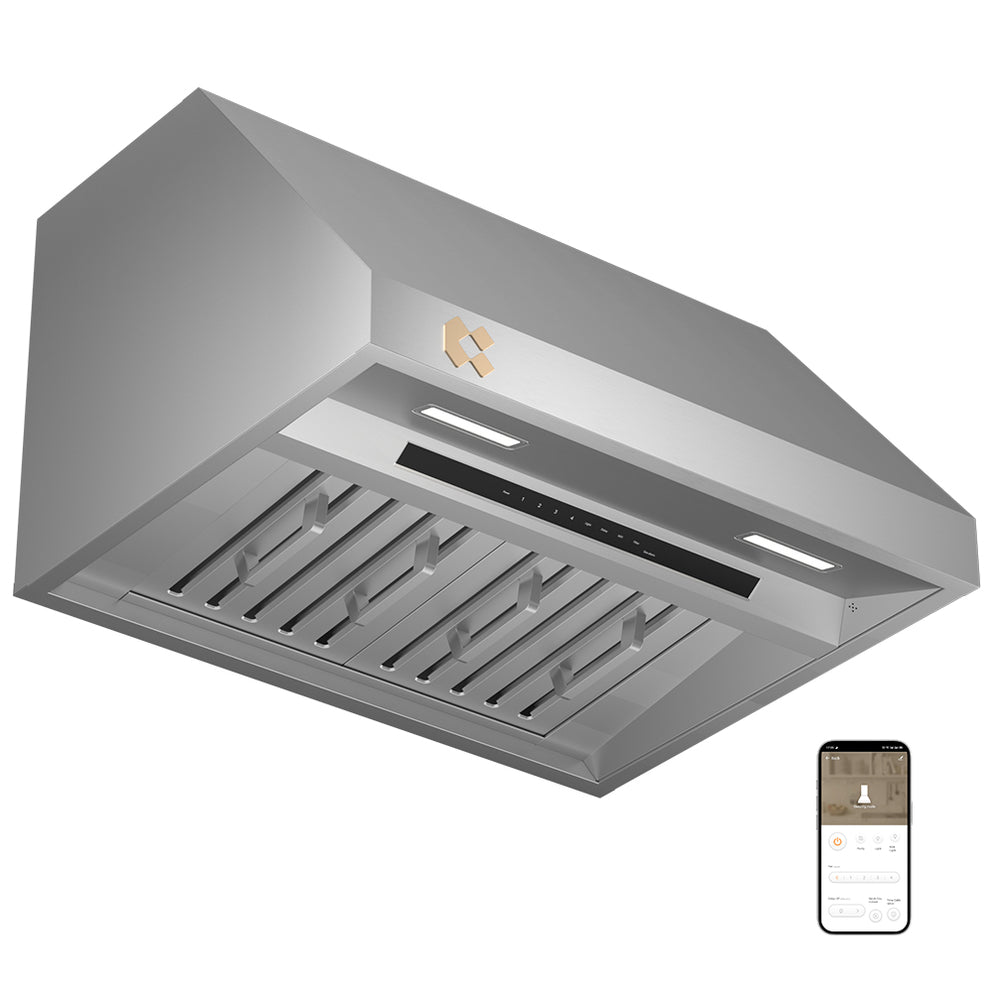A commercial range hood is an essential appliance in professional kitchens, designed to remove smoke, grease, and odors efficiently while maintaining a safe cooking environment. Whether you are outfitting a restaurant, café, or large-scale kitchen, choosing the right range hood is critical for performance, safety, and compliance with local regulations.
In this ultimate guide, we will cover everything you need to know about commercial range hoods, including types, materials, installation, airflow ratings, and maintenance. We will also link to detailed articles on specific models and installation techniques to help you make the best choice.
What Is a Commercial Range Hood?
A commercial range hood is a ventilation system designed for high-capacity cooking environments. Unlike residential hoods, commercial hoods must handle heavy smoke, grease, and steam produced by multiple burners or high-output cooktops.
Key features of a commercial range hood:
- High airflow capacity (measured in CFM, cubic feet per minute)
- Durable materials like 304 stainless steel for long-term corrosion resistance
- Compliance with fire safety standards and local codes
- Advanced filtration systems to capture grease and smoke
Related: Learn more about 304 stainless steel range hoods and why they are preferred in commercial kitchens.

Types of Commercial Range Hoods
Commercial range hoods come in several types, each designed to meet the specific demands of different cooking environments. Choosing the right type is crucial for performance, kitchen safety, and compliance with local codes.
Vented (Ducted) Range Hoods
Vented, or ducted, range hoods are designed to remove smoke, steam, odors, and airborne grease by channeling them outside through a dedicated duct system. They are the most common choice in commercial kitchens due to their superior performance and efficiency.

Key Advantages:
- High airflow efficiency: Ideal for heavy-duty cooking that produces significant smoke or grease. Many commercial kitchens require 900 CFM range hoods or higher to maintain air quality.
- Better odor control: Venting air outdoors prevents lingering cooking smells from spreading throughout the kitchen or dining areas.
- Compliance with safety codes: Most fire codes prefer or require ducted systems in professional kitchens, particularly for gas stoves.
Considerations:
- Requires professional installation of ductwork.
- May be limited by building layout or space constraints.
- Periodic duct cleaning is needed to prevent grease buildup.
Cluster Link: Check our article on under cabinet vented range hood for detailed guidance on choosing and installing vented systems.
Ductless (Recirculating) Hoods
Ductless or recirculating hoods filter the air and return it to the kitchen rather than venting outside. They use grease filters (usually stainless steel baffles) and optional carbon filters to capture odors.
Key Advantages:
- Flexibility in installation: Ideal where ducting is difficult or impossible, such as in rented spaces or islands without ceiling access.
- Lower installation cost: No external venting reduces labor and material expenses.
Considerations:
- Less efficient at removing heat and moisture compared to ducted hoods.
- Carbon filters require regular replacement to maintain odor control.
- Typically recommended for light to medium cooking volumes, not high-output professional kitchens.
Tip: Even in commercial settings, ductless hoods are suitable for small prep kitchens, cafés, or secondary cooking stations.
Wall-Mounted vs. Island Hoods
The mounting style affects performance and kitchen design:
- Installed directly above a stove or cooktop against a wall.
- Easier to vent outside as ductwork can run directly through walls or ceilings.
- Popular in both small and large commercial kitchens for space efficiency.

Island Hoods:
- Suspended above a central island cooktop.
- Require higher suction power to capture smoke rising from all sides.
- Often larger and equipped with enhanced airflow technology to maintain air quality.
- Ideal for open kitchens or modern restaurant layouts where cooking is a centerpiece.
Tip: When selecting an island hood, choose models with powerful fans and optional noise reduction features for a comfortable kitchen environment.
Size Variations
Commercial range hoods come in multiple widths to match cooktop sizes and kitchen needs. Selecting the correct size ensures maximum capture of smoke and grease:
- 36-inch range hood: Standard width for most professional cooktops. Suitable for 4-burner stoves and common in restaurants and catering kitchens.
- 30-inch range hood: Slightly smaller, ideal for compact kitchens or smaller commercial setups. Perfect for 2–3 burner cooktops while still maintaining high efficiency.
- 28-inch and other custom sizes: Available for specialty applications, such as prep stations or kitchenette setups. Custom sizes can also be designed to cover multiple smaller cooktops in a modular kitchen.
Larger commercial hoods: For high-output stoves with multiple burners, 48 inch, 60 inch, or even larger hoods are available to ensure complete smoke capture.
Cluster Link: Explore 36 inch range hood options and sizing guides to determine the best fit for your kitchen layout.
Choosing the Right Commercial Range Hood
Selecting the right commercial range hood involves understanding your kitchen’s cooking needs, layout, and safety requirements. Below is a detailed breakdown of the main factors you need to consider.
1. Airflow Capacity (CFM)
Airflow capacity, measured in CFM (cubic feet per minute), determines how much air the hood can move per minute and is critical for keeping your kitchen smoke-free and odor-free.
How to calculate the required CFM for your kitchen:
- Measure cooktop size: Multiply the total width (in inches) of your cooktop by the depth to get the cooking area.
- Consider heat output: Gas stoves produce more heat and grease than electric cooktops. Higher BTU output requires higher CFM.
- Use the general formula:
- For commercial kitchens:
- Typically, commercial kitchens aim for 15–20 air changes per hour.
Rule of thumb:
- Standard 4-burner stove → ~850 CFM
- High-output gas range → 1000–1500 CFM or more
Cluster Link: Learn more about 900 CFM range hood for high-intensity cooking.
Tip: Always round up to ensure sufficient suction, especially in busy commercial environments.
2. Type of Cooktop
The type of cooktop directly impacts the type and capacity of the range hood needed.
Gas Stoves:
- Produce higher heat and grease than electric or induction cooktops.
- Require higher CFM and more robust grease filters to prevent buildup.
- Some commercial hoods come with gas leak detection sensors or automatic shutoff mechanisms for added safety.
- Consider hoods with adjustable fan speeds for varying cooking intensity.

Electric/Induction Stoves:
- Lower grease output, allowing for slightly lower CFM models.
- Filtration requirements are simpler; however, ventilation for steam and odors is still necessary.
Cluster Link: Check out range hood for gas stove for tailored solutions for gas cooktops.
Tip: Match the hood type and CFM to your primary cooktop fuel type for optimal performance.
3. Material and Build Quality
Durability and ease of cleaning are essential in commercial kitchens.
304 Stainless Steel:
- Industry standard due to excellent corrosion resistance and high durability.
- Smooth surface makes cleaning grease and grime easier.
Other considerations:
- Welded or reinforced seams prevent grease leakage and improve hygiene.
- Fire-resistant coatings or baffle filters increase safety in high-heat applications.
Tip: Avoid lower-grade metals that may rust or degrade under constant heat and humidity.
4. Installation Considerations
Proper installation ensures optimal airflow, efficiency, and safety.
Installation Height Guidelines:
- Gas ranges: 30–36 inches above the cooktop
- Electric/induction ranges: 24–30 inches above the cooktop
- Island hoods: Generally 30–36 inches above the cooking surface, but may vary based on fan power and kitchen layout
Professional installation ensures:
- Correct duct sizing and routing to maximize suction
- Compliance with fire codes and health regulations
- Proper clearance to prevent heat and grease hazards
Cluster Link: Read our detailed guide on How to Install Professional Range Hood.
Tip: Always follow the manufacturer’s recommended height to balance efficiency and safety.
Advanced Features to Consider
Modern commercial range hoods offer features to improve efficiency and comfort:
- LED lighting: Provides clear visibility of the cooking area without excessive heat.
- Variable speed fans: Allows energy savings and quieter operation at low cooking loads.
- Noise reduction technology: Critical in open kitchens or restaurants where staff comfort is important.
- Smart controls: Some high-end models include timers, automatic fan adjustment, or app connectivity.
Tip: Invest in features that match your kitchen workflow—advanced controls can save energy and reduce long-term operational costs.
Maintenance and Cleaning
Regular maintenance prolongs the lifespan of your commercial range hood and ensures peak performance.
- Grease filters: Clean weekly or monthly depending on usage; consider hoods with removable baffle filters for easier cleaning.
- Stainless steel surfaces: Wipe daily with non-abrasive cleaners to prevent buildup.
- Ductwork: Inspect periodically for grease or debris blockages that can reduce airflow and pose fire risks.
Tip: Establish a cleaning schedule and log to maintain compliance with health and safety regulations.
You may also be interested in:
Common Range Hood Problems and How to Fix Them
Why Is the Range Hood Dripping Water?
5 Ways to Clean Stainless Steel Range Hood
Compliance and Safety
Commercial kitchens must adhere to local codes and safety standards:
- NFPA 96 (U.S.) or equivalent standards internationally for ventilation and fire suppression.
- High-output gas ranges may require integrated fire suppression systems within the hood.
- Ensure hoods are installed to meet clearance, ducting, and airflow regulations to pass inspections.
Tip: Check local regulations for duct materials, fan capacity, and suppression requirements before purchase.
CIARRA Professional Series Range Hood- Commercial Range Hood
Behind the Development of the CIARRA Professional Series Range Hood
At CIARRA, every product begins with a simple yet ambitious mission: to redefine the professional kitchen experience. The development of the Professional Series Range Hood was no exception. The project began with a vision to create a commercial-grade range hood that combines durability, intelligence, performance, and safety, addressing the real needs of both professional chefs and home cooks seeking high-end kitchen efficiency.
Step 1: Designing a Super-Sturdy Exterior
The CIARRA engineering team started by focusing on the range hood’s shell. Recognizing that commercial kitchens demand appliances that withstand high heat, humidity, and heavy use, the team tested over 12 different stainless steel alloys. Finally, 304 stainless steel was selected for its perfect balance of corrosion resistance, high-temperature stability, and sleek modern aesthetics. In lab tests, prototypes made from 304 stainless steel resisted over 1,000 hours of salt spray corrosion testing and maintained structural integrity under temperatures exceeding 220°F (104°C) for prolonged periods.

“We knew the exterior had to endure years of rigorous kitchen environments, and 304 stainless steel offered the ideal solution,” explains Michael Tan, CIARRA’s Lead Materials Engineer.

Step 2: Crafting the Perfect Smart Control System
Next, the focus shifted to user interaction. Modern kitchens demand convenience, and CIARRA’s product developers aimed for a touch-sensitive smart control system that could be intuitive, responsive, and integrated with smart home ecosystems. The team conducted 500+ hours of user testing with chefs and home cooks to refine the touch panel sensitivity, the menu layout, and smart features like voice commands via Alexa and Google Home, WiFi control, and filter cleaning reminders.
Data from usability tests showed that 95% of participants could adjust fan speed or lighting without referencing the manual, demonstrating a highly intuitive interface.
Step 3: Maximizing Suction Power
No professional kitchen experience is complete without powerful airflow. The engineers tested over 20 fan designs to optimize both CFM (cubic feet per minute) output and noise levels. The final model delivers up to 950 CFM, capable of handling the intense smoke and grease from high-output gas ranges. The team used computational fluid dynamics (CFD) simulations to optimize the motor housing and duct design, reducing turbulence while maintaining a quiet 8.5 sones (67 dB) operation.
“Our goal was to balance power and quiet operation. Chefs need both,” notes Sophia Li, CIARRA’s Head of Product Development.
Step 4: Prioritizing Safety
Commercial kitchens pose multiple risks, particularly with gas stoves. CIARRA integrated gas leakage detection sensors to alert users in case of any dangerous leaks. Additionally, the hood’s dual ventilation system ensures proper expulsion of smoke and harmful particles while maintaining safe indoor air quality. Every hood undergoes rigorous compliance testing to meet NFPA 96 standards in the U.S., and equivalent international safety certifications.
Step 5: Serving the Right Audience
From day one, the development team focused on understanding who would benefit most from the Professional Series Range Hood:
Professional chefs requiring continuous, high-intensity cooking in restaurants or catering environments.
Home culinary enthusiasts with premium kitchen setups, often using gas stoves, multi-burner cooktops, or large kitchen islands.
Tech-savvy users who value integration with smart home devices and easy maintenance features.
Each feature, from the dishwasher-safe baffle filters to the Plasma⁺ optional air purification system, was designed to meet the expectations of this audience.
Step 6: Iterative Testing and Optimization
Before launch, CIARRA conducted a 12-month intensive testing cycle across multiple kitchen environments. This included:
- Continuous operation tests: 12 hours/day for 30 days to ensure motor stability.
- Grease capture tests: ensuring filters remove >90% of airborne grease.
- Smart system tests: 100+ software cycles to guarantee WiFi connectivity and voice command reliability.
The result is a range hood that combines professional-grade performance with smart home convenience, robust durability, and uncompromising safety.
In short: The CIARRA Professional Series Range Hood is the culmination of engineering precision, user-focused design, and professional-grade durability. Every component, from the 304 stainless steel body to the 950 CFM motor and smart control system, was developed to provide a superior cooking environment for chefs, culinary enthusiasts, and smart-home aficionados alike.
1. CIARRA Professional Series 36 & 30 inch Wall Mount Range Hood | CAS36313A-OW
Price: 36 inch – $1799.99 | 30 inch – $1399.99
Key Advantages & Selling Points:
- Powerful Suction for Professional Kitchens
- Maximum airflow of 950 CFM efficiently captures grease, smoke, and odors, keeping your kitchen air fresh.
- Cast aluminum motor housing ensures durability and stable performance for long-term use.
Smart Controls & Voice Operation
- Supports WiFi + Voice + Smart Life App, compatible with Alexa and Google Home for remote control and smart management.
- Touch control panel with 4-speed levels + Boost function allows precise adjustment of airflow.
Plasma⁺ System Compatibility
- Optional Plasma⁺ air purification system for dual-mode operation: vent externally or purify internally.
- Keeps kitchen air cleaner and reduces lingering odors.
Safety & Convenience Features
- Gas leakage detection sensors for enhanced kitchen safety.
- Delay shut-off function ensures continuous ventilation after cooking.
Easy-to-Clean Design
- Dishwasher-safe baffle filters are removable for hassle-free cleaning.
- Filter cleaning reminders help maintain optimal performance.
Durable Material & Modern Design
- Made from 304 stainless steel, resistant to rust, corrosion, and high temperatures.
- Sleek, professional design complements modern kitchens.
2. CIARRA Professional Series 34 & 28 inch Built-In Range Hood | CAS34927A-OW
Price: 34 inch – $1399.99 | 28 inch – $1199.99

Key Advantages & Selling Points:
- High-Performance Suction
- Up to 950 CFM ensures effective removal of smoke, grease, and cooking odors.
- Superior cast aluminum motor housing for stable and long-lasting operation.
Smart & Convenient Controls
- Touch control panel with 4-speed levels + Boost function.
- WiFi-enabled, compatible with Alexa, Google Home, and Smart Life App for voice and remote control.
Dual Ventilation Options
- Can expel air externally or work with the optional Plasma⁺ System for internal purification.
Safety Features
- Equipped with gas leakage detection sensors for safer cooking environments.
- Delay shut-off function for post-cooking ventilation.
Hassle-Free Maintenance
- Dishwasher-safe baffle filters simplify cleaning.
- Filter cleaning reminders help maintain efficiency.
Compact & Professional Design
- Built-in design fits seamlessly into kitchens.
- Stainless steel construction provides durability, rust resistance, and a modern aesthetic.
CIARRA vs. Competitors: Professional Range Hood Comparison
| Feature | CIARRA Professional Range Hoods | Proline Range Hoods | ZLINE Range Hoods | Broan-NuTone Range Hoods |
|---|---|---|---|---|
| Max Airflow | 950 CFM | Up to 2000 CFM | Up to 700 CFM | Up to 350 CFM |
| Smart Features | Yes (WiFi, Voice Control) | No | No | Limited |
| Gas Leak Detection | Yes | No | No | No |
| Dual Ventilation Options | Yes (External & Recirculating) | Limited | Limited | Limited |
| Dishwasher-Safe Filters | Yes | Yes | Yes | Yes |
| Material | 304 Stainless Steel | 304 Stainless Steel | 430 Stainless Steel | Stainless Steel |
| Price Range | Mid-High | Mid-High | Mid | Low-Mid |
CIARRA's professional range hoods stand out in the market due to their combination of advanced features, high-quality materials, and competitive pricing. The integration of smart technologies, gas leak detection, and dual ventilation options provides enhanced safety and convenience for users. Additionally, the use of 304 stainless steel ensures durability and ease of maintenance.
When compared to competitors like Proline, ZLINE, and Broan-NuTone, CIARRA offers a balanced mix of performance and affordability, making it a compelling choice for both residential and commercial kitchens.
CIARRA Professional Series Range Hood Review
A young professional chef recently shared his experience using the CIARRA Professional Series Range Hood, alongside CIARRA’s five-burner induction cooktop and premium cookware set. His review highlighted how the brand seamlessly blends powerful performance, modern design, and smart functionality to meet the demands of serious cooking.

He praised the baffle filter system, noting that it delivers exceptional grease and smoke capture even during high-heat cooking. What impressed him most was the ease of maintenance — the stainless steel filters can be easily removed and placed directly into the dishwasher for quick cleaning, saving valuable time in a busy kitchen.
The chef also emphasized the range hood’s smart features. By connecting the hood to the Smart Life app, he could adjust the fan speed, control the LED lighting, and manage settings remotely from his smartphone. He described the app integration as “a game-changer,” offering convenience and precision at his fingertips.
 |
 |
In addition to its strong performance, he admired the aesthetic appeal of the CIARRA Professional Series. The sleek stainless steel design gives the kitchen a modern, professional look. The chef noted that the hood doesn’t just perform flawlessly — it also enhances the overall ambiance of the space, making the kitchen both functional and beautiful.
Conclusion
The CIARRA Professional Series Range Hood is more than just a kitchen appliance — it’s a fusion of professional-grade performance, intelligent design, and modern aesthetics. Designed for chefs and passionate home cooks alike, it delivers exceptional suction power, effortless maintenance, and seamless smart control through the Smart Life app. Whether in a commercial or home kitchen, CIARRA proves that efficiency and elegance can coexist beautifully, redefining what a professional range hood should be.
Explore CIARRA® Professional Range Hoods
Clearing the air so you can sear, simmer, and flambé is a must for any adventurous cook. That’s why CIARRA® Professional range hoods are engineered to handle the demands of high-performance cooking. Breathe new life into your kitchen with a CIARRA® Professional range hood built to meet your culinary needs.



